How to Bring in Images Again to Lightroom to Restructure but to Keep the Edits You Did on the Phots
Lightroom has become a very essential office of the workflow process for many photographers, including myself. I cannot imagine managing my photo itemize without Lightroom and I utilize it every 24-hour interval for my photography needs. In fact, 95-98% of my mail-processing piece of work is washed in Lightroom and I only occasionally apply Photoshop for advanced photograph editing / retouching, which not only simplifies my workflow, merely also decreases the amount of time I spend on post-processing. Over the past few years of using Lightroom extensively, I accept come upwardly with efficient means to shop, organize and access photos on my figurer, so I wanted to share a few tips with our readers on how I practice it for both personal and professional work. Although in that location are many ways to organize images, this item method has been working slap-up for me (and many others that accept been reading our site for the past few years). If yous are looking for a generic guide on doing this without any tertiary party photograph software similar Lightroom, and so delight read my older article on "how to properly organize pictures".
Table of Contents
one) Where do you shop your pictures and how?
The get-go question is, where and how do yous currently shop your pictures? I used to store all of my photographs in various subfolders of my hard drive (commonly in "My Pictures" or "My Documents"), but after I got into photography, I decided that information technology was best to keep all of my photographs in the root folder of my PC's hard drive that I use solely for storing photos and small family unit videos. Difficult drives are really inexpensive nowadays, so creating a properly organized and redundant storage for your photography needs does not accept to cost an arm and a leg.
For those on a budget, I highly recommend getting a error-redundant external RAID array (two difficult drives that can exist configured in RAID 1 / Mirror configuration). If you shoot RAW like me and have a lot of photographs, my favorite solution on the market today is Synology (v bay) and if you lot have lots of photographs, I would get the viii bay version. With larger capacity hard drives, you could become a boatload of storage on even the five bay version. These are rock-solid solutions for photographers and they easily outperform the proprietary Drobo system. The dainty thing about a storage array unit like this, is that it is configured for speed and redundancy. If a single drive fails, the arrangement continues to run, just prompts you to replace the faulted drive equally before long as possible. One time you replace the bulldoze and everything re-syncs, the system goes back to regular operational mode.
ii) Folder structure and system
Now that y'all have figured out where you will be storing your pictures, it is fourth dimension to effigy out what your binder structure will exist. At that place are many ways to do this and everyone does it differently. I will show you what works for me and volition leave it up to y'all to determine whether y'all want to adopt it or create your own. Here is my current construction:

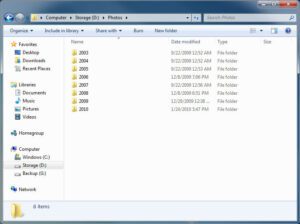
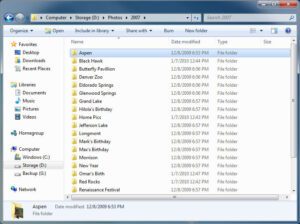
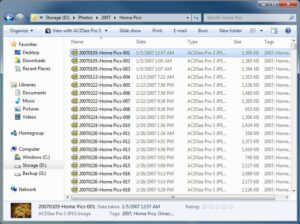
In the root of my hard drive, I have one folder called "Photos", where I store all of my pictures. Inside "Photos", I create one binder per year. Then inside each year, I store photographs past events. For example, a family trip to Denver Zoo in 2007 is stored in "Photos\2007\Denver Zoo". If you shoot professionally, you might desire to have two separate folders under "Photos" – ane for your personal pictures and i for your professional work. In that example, simply add another level of folders underneath "Photos" and your structure would look like "Photos\Personal\2014\My Event" or "Photos\Professional\2014\My Event".
Get ahead and create the first pinnacle level folder "Photos" and if you lot desire to separate your personal and professional work, also create the ii folders underneath. Exercise Not create any more folders underneath and do Not motion or add whatever photos all the same.
3) Create a new Lightroom catalog
Once you ascertain and create your initial construction, it is now time to create a Lightroom catalog. First off with a new Lightroom catalog by going to File -> New Catalog. For performance reasons, I prefer to store my catalog along with prototype previews on a fast SSD drive, while storing the pictures on a fast external storage array, merely yous might desire to keep it all in the same drive for simplicity purposes. If you have under x,000 pictures, you can store them all in a single itemize without much touch on Lightroom performance. If you have over x,000 pictures, then I recommend creating 1 Lightroom catalog per year. Just create one folder in the root binder chosen "Lightroom" and store all of your catalogs in that location.
four) Modify Lightroom Preferences
For every new catalog I create, I slightly modify the default settings to fit my needs. Although y'all can do this later, information technology is probably all-time to do information technology in the outset, as you might forget to take care of it after. The first affair I brand sure is ready right (you lot only need to practise information technology once) is Lightroom Preferences. Go to Edit -> Preferences and under the "General" tab, set similar settings as shown beneath:
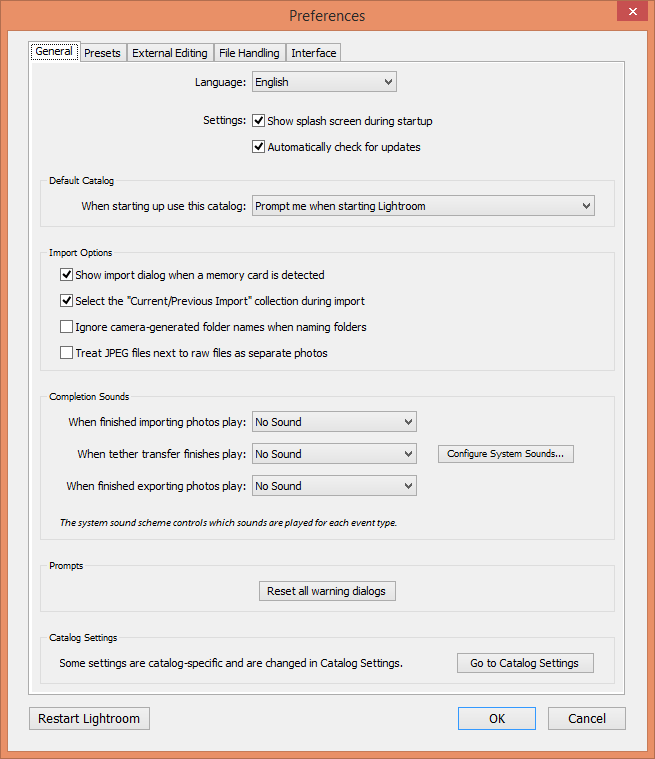
There are two settings that I inverse here. I modified the "Default Catalog" option, where I ready information technology to "Prompt me when starting Lightroom" – this basically makes Lightroom prompt which catalog I desire to load when I start up Lightroom, which is convenient if you use multiple catalogs. If you merely have a single catalog, in that location is no need to change the default setting. The 2d option is "Show import dialog when a memory bill of fare is detected", which just tells Lightroom to automatically fire upwards the import screen when you insert your memory card.
The next tab is "Presets", where I typically leave everything past default. The only matter that is worth mentioning on this page is the "Location" where you lot can bank check or uncheck "Store Presets with Itemize". Lightroom allows storing your user presets (such as default import settings, file naming convention, copyright information, etc.) either in a general folder that is used for all of your catalogs, or in each of your Lightroom catalogs where you can set up different presets depending on the catalog. I personally use one preset for all of my Lightroom catalogs and recommend leaving this option unchecked equally seen below:
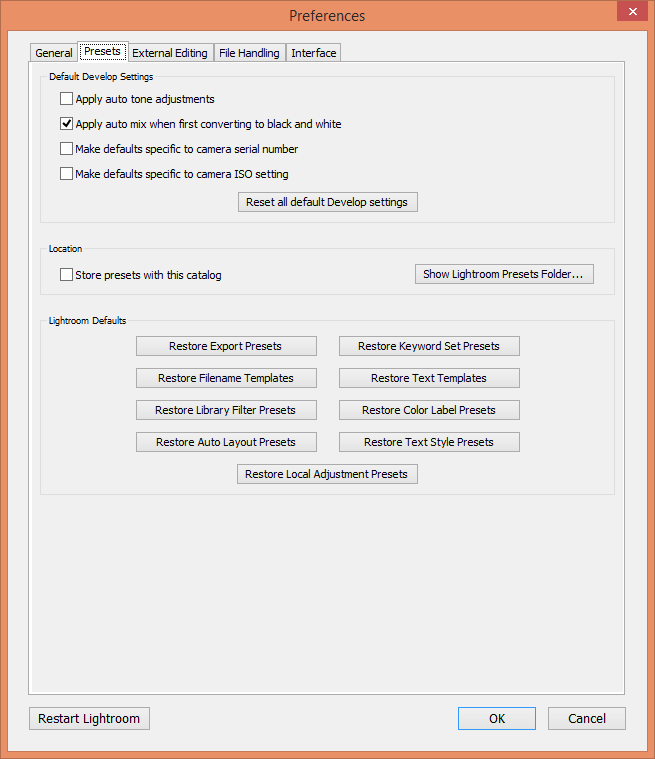
The next tab called "External Editing" allows y'all to specify the default File Format and Color Infinite for use in external applications such as Adobe Photoshop. If yous use RAW format for your images, you should ever edit images in Photoshop with the best format that preserves all image details and the widest colour space. I use TIFF format (default) for files and ProPhoto RGB (default) for colour infinite for this reason. Bit Depth should evidently be 16 bits and I leave the resolution at 240 (default), with Nada every bit the compression method:
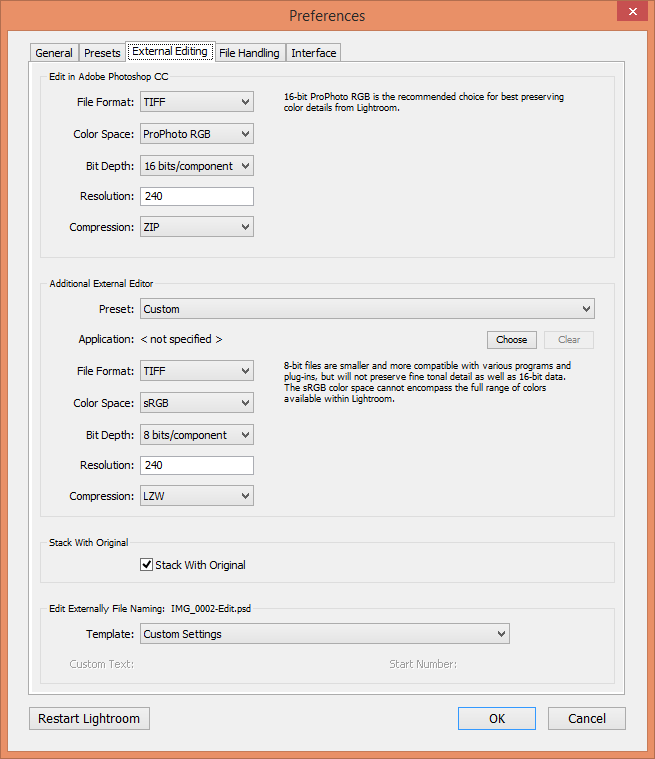
I also leave "Stack With Original" checked, so that an epitome that is edited externally stays fastened to the original RAW file.
Let'southward now motility to the "File Treatment" tab. This particular tab is very important, considering it controls the way your pictures are imported into the catalog. Here is how I have my File Handling tab set:
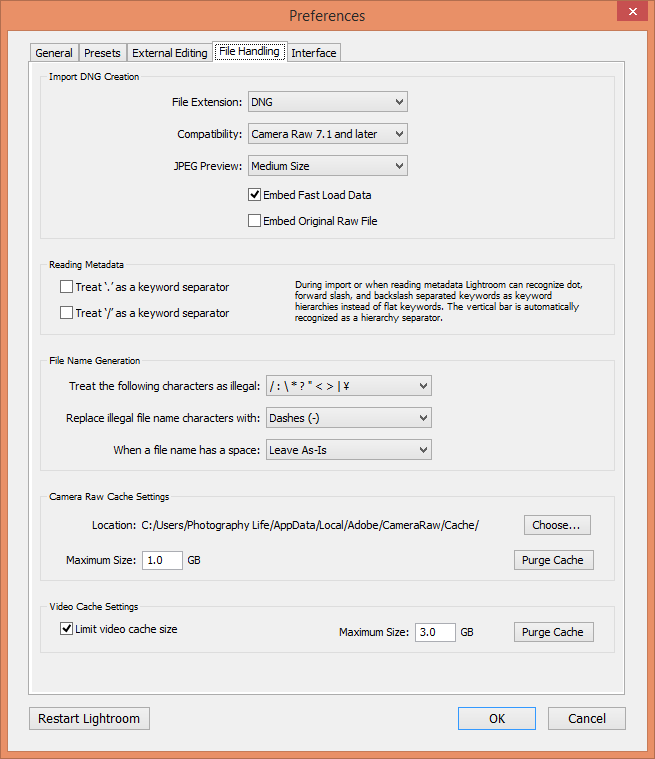
Pay attention to the "Import DNG Creation" settings on this folio. I set up "File Extension" to "DNG", "Compatibility" to the latest Camera Raw version available, "JPEG Preview" to "Medium Size" and left "Embed Original Raw File" unchecked. The of import settings here are "JPEG Preview" and "Embed Original Raw File" that control the total size of your DNG files (read more nigh the DNG format here). Past default, every RAW paradigm contains a full-size JPEG paradigm (run across RAW vs JPEG) inside that is stored every bit a "Preview" (the "Preview" epitome is what y'all see on the back of your camera when you take a film). By setting the "JPEG Preview" option to "Medium Size", yous are telling Lightroom to generate a smaller version of a preview inside DNG files, which will save you up to 15-xx% of space per file (depending on the size of the RAW file). While y'all might think that information technology is non such a big deal, it does a make a huge difference when you have tens of thousands of pictures. The only punishment is the fact that the image opens slightly slower when yous try to open up a full version of it in Lightroom later, merely considering it has to generate a total size version from the RAW image. If the speed is of import, you could e'er generate full size previews in Lightroom after. The checkbox "Embed Original Raw File" is something I would recommend to get out unchecked, because if you check it, your DNG files volition actually be much larger than the original RAW file (DNG + RAW volition be combined in a single file).
I exit the concluding "Interface" tab at its default settings.
v) Modify Lightroom Catalog Settings
The next thing we need to modify, is your Lightroom Catalog Settings. You will have to do this once for each of the catalogs that yous create. Get to Edit -> Catalog Settings to bring upwards the "Catalog Settings" window. I commonly leave everything to default values in "Full general" and "File Handling" tabs. Still, if you desire Lightroom to render bigger previews to match your monitor resolution, pick a unlike value nether "Standard Preview Size". Note that the larger the preview size, the more space Lightroom's cache volition have on your hard drive.
The most important tab for me here is the "Metadata" tab, where I can specify what data is written into my images past Lightroom:
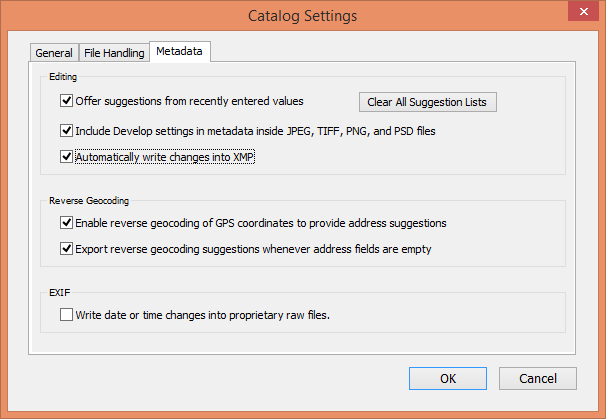
The first two options "Offer suggestions from recently entered values" and "Include Develop settings in metadata within JPEG, TIFF, and PSD files" are checked by default and I practice not bear on them. The last option "Automatically write changes into XMP" is unchecked by default. This is the one I unremarkably recommend to turn on, because it makes Lightroom write your changes correct into the DNG files (or XMP sidecar files that go with your RAW files) every bit you work on them. Why is it of import? Because if your Lightroom catalog was to fail and you lost all of your catalog data, the epitome file would notwithstanding keep all changes that yous've made in Lightroom! It is also very useful if y'all happen to open that same file in Photoshop or other Adobe applications, because all changes volition be immediately visible as you work on the file. And if you were to lose your Lightroom catalog completely, yous could just import all the images from your hard bulldoze and all changes would migrate through (except for the history). The punishment of keeping this option checked is slower performance, since every modify is immediately written to the DNG / Sidecar file. If operation becomes a trouble, you tin turn off this setting and occasionally forcefulness Lightroom to salvage changes to files by selecting all files (CTRL+A in the root folder) and saving changes (CTRL+S).
6) Import your photos into the Lightroom catalog
Your preferences and catalogs settings take now been modified. Permit's start importing your pictures! Fire upwardly the photo import catalog by going to File -> Import Photos… or press CTRL+SHIFT+I on your keyboard. One time the import screen comes up, it will wait like the following:

The entire import screen is organized very similarly as Lightroom itself, the left side beingness the location where you lot will be grabbing the files from, while the right side serves every bit the destination side, along with import settings. The middle section shows all images to be imported. The "From" section has been designed in such a way that Lightroom is able to differentiate between permanent storage and your device or bill of fare reader. The nice thing is, the import screen is dynamic, pregnant whatsoever changes happen in the organisation, the screen gets updated in real time. For example, if y'all open the import screen then disconnect your camera from the PC, the device will simply disappear from the screen. Reconnecting the camera will add together the device back into the screen.
Since I standardize on the DNG format, I typically get out "Copy as DNG" selected in the top middle section. If you choose to go along the original RAW files, and then pick "Re-create" instead.
The right import menu consists of several sections: File Handling, File Renaming, Apply During Import and Destination. Permit'southward take a look at the first two sections – File Handling and File Renaming:
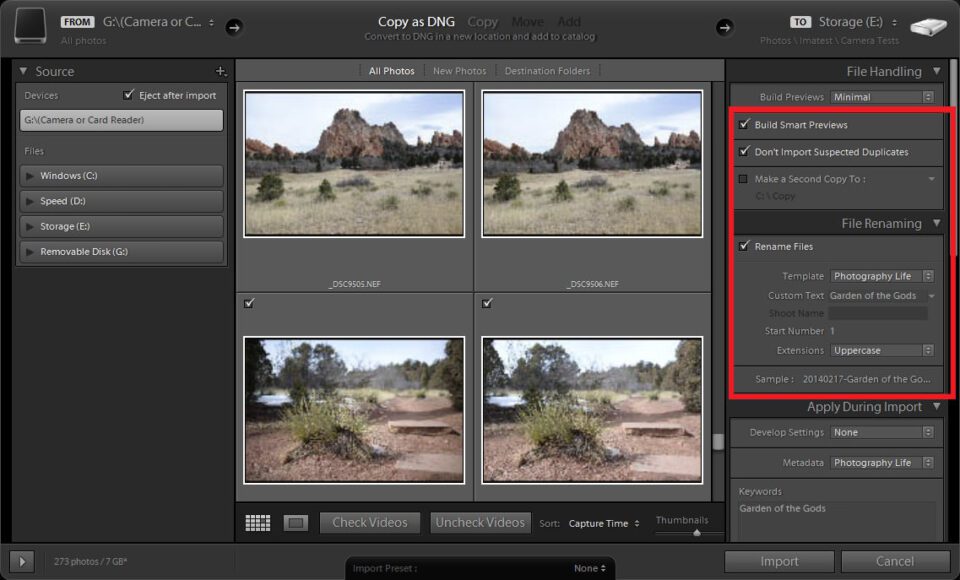
6.1) File Treatment Section
The File Treatment department consists of four choices – "Build Previews", "Build Smart Previews", "Don't Import Suspected Duplicates" and "Brand a 2nd Copy To". I go out the Build Previews option on "Minimal" to save time during file import. However, if you have plenty of storage and you want to speed up the time it takes for your files to return when yous zoom into them, y'all can set this selection to "1:1", which volition generate total previews. Normally, I don't recommend this, unless you want to speed up the procedure of editing high resolution files (see my article on efficient Lightroom workflow for loftier resolution images).
The "Build Smart Previews" option tin can be very useful for situations where you have a laptop that stores simply the catalog and your actual images are stored on external storage. If you happen to travel and need to disconnect from your storage, keeping this option turned on volition create epitome previews that you will be able to work on, as if you lot were nevertheless connected to your storage. Once you come up dorsum and reconnect to your external storage, all the changes will be retained. If you are using a desktop PC and the storage is attached permanently, I would turn this option off.
I e'er go on "Don't Import Suspected Duplicates" turned on and I do non apply Lightroom's fashion to dorsum upwards imported images, and so I keep the final choice "Make a 2d Copy To" turned off.
6.ii) File Renaming Department
The File Renaming department consists of variables that are used for renaming your files. I always rename my files to the post-obit format: "YYYYMMDD-Custom Text-Sequence Number.DNG". The kickoff role is the file engagement, for example "20140217", which stands for February 17, 2014. Then a nuance is followed with a custom text that I type during each import, which is then followed by an incremented sequence number. I like renaming my photos, because I do not like to keep photo names like "DSC_1000.DNG" that mean cypher and get duplicated over fourth dimension. By renaming the photos, I know that I could only take all images from all folders and put them all into a single folder without running into indistinguishable file names. I highly recommend taking the aforementioned or a similar approach and uniquely identify every image yous import.
If you have not already created a rename template, take a wait at the post-obit:
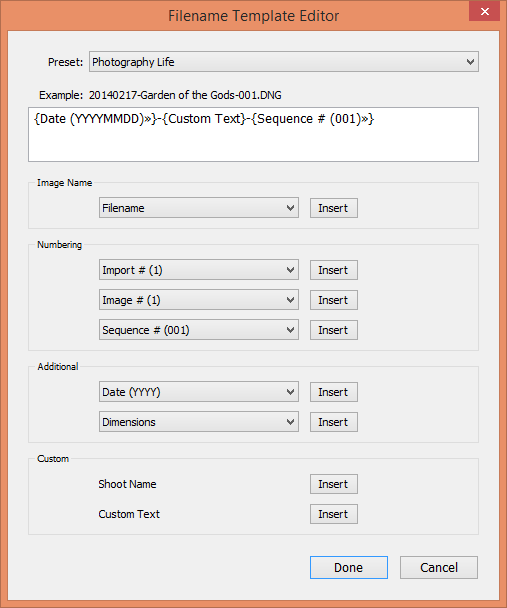
Create a similar template, and then save it equally a Preset and click "Done". Then but select your preset under the "Template" drop-down.
The next field nether "File Renaming" is Custom Text – the text you can blazon to place images. For this example, I used "Garden of the Gods" equally custom text, which means that my start file volition be named like "20140217-Garden of the Gods-001.DNG". The "Outset Number" field lets you type the first number that the system will use, so if you type "500", your first file proper noun will have a sequence number of 500 and all sequent numbers will exist incremented by one. This is very useful during multiple imports into the aforementioned folder structure – I simply look at the total number of photographs in my retentiveness card and put the number in that field. I always get out the extension in upper-case letter for consistency.
vi.three) Use During Import Department
This section is some other of import i, since it lets you choose an import preset with your Lightroom settings, write Metadata and Keywords into each image equally it gets imported. I accept already made some changes to the way I import files and being able to choose what y'all want before the import process starts is a smashing thought, considering it saves tons of time for me during the image editing process. Once you brand changes to an image and save the preset, it volition immediately testify up on this screen.
The next field is called "Metadata" and it is used for writing boosted data into each imported file. For example, if I wanted to include my copyright text in every epitome (do non misfile this with a watermark), I would need to create a new Metadata preset and make some changes:
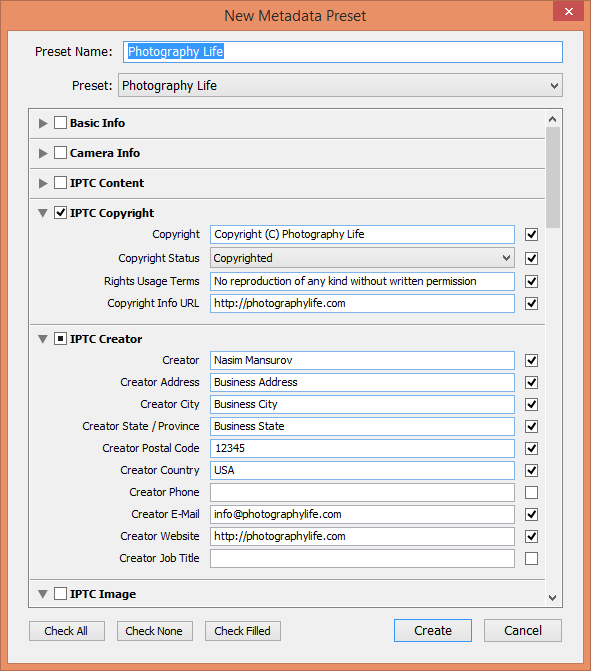
I wouldn't waste product time by filling out every single field and only pay closer attention to IPTC Copyright and IPTC Creator fields, where yous can provide your proper name and contact information.
The final field is "Keywords" and that's where I type keywords related to what I am importing. Keywords can be bang-up to be able to locate photos past outcome, location, theme, etc. For the higher up example, I used "Garden of the Gods" keyword, which saves this keyword to each file and the Lightroom database. If I get back to the Garden of the Gods over again later this year, I would use the same Keyword to group the two events together. That way, fifty-fifty if I stop upward putting photos into different folders, I will withal be able to locate them by this keyword.
6.4) Destination Section
The last section identifies the location of where the import process volition store files. The first field is called "Into Subfolder", which I always leave checked, since I do want Lightroom to create subfolders for me. The adjacent field is a driblet-down with two options: Organize "By Date" and Organize "Into 1 folder". If yous select Organize "By Date", you lot will get an boosted field called "Date Format", where you can specify the format of the subfolders that will be created by Lightroom. Since I already have a folder for each twelvemonth and my file names already contain the full engagement, I exercise not experience the need to create subfolders for year, month and day. Instead, I like to keep everything simple and organized, instead of having many different subfolders in the organization. Therefore, I always cull "Organize Into 1 Folder" and then type the name of the subfolder:
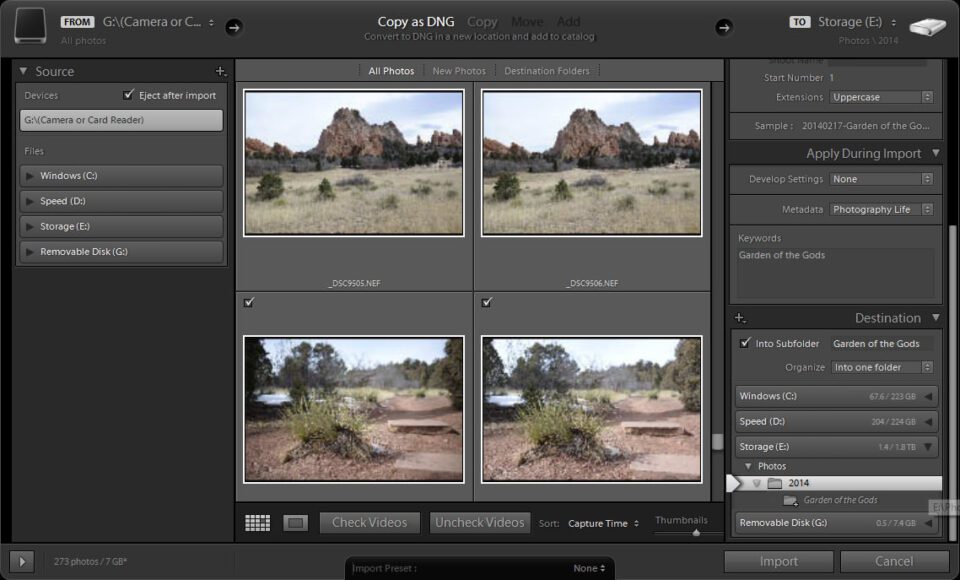
Since I store all of my images in a master folder called "Photos" and then subfolders by yr, I simply select the twelvemonth under "Photos", as shown higher up.
As you can see, the arrangement is gear up to create a folder nether "E:\Photos\2010" called "Gardens of the Gods", where all the photos volition be imported. If I pay some other visit to the Garden of the Gods, I will choose the same folder and the system will create files with a different date, so I won't ever run into whatsoever problems with indistinguishable file names.
I always sort my import images past "Capture Fourth dimension" under "Sort" drop-downwardly. Once y'all choose the destination binder, just click the "Import" button to starting time importing your images. The import window will go away and you will beginning seeing the images popping up in your Lightroom catalog.
seven) Mail-import check
Now that yous know how to import your images with custom templates, become ahead and import all of your pictures into Lightroom and brand certain that everything gets transitioned correctly. Do not forget to change the folder names forth with "Custom Text" and "Keywords" fields upon each new import in the "Import Photos" screen going forward. Otherwise, yous volition cease upwards with a bunch of unwanted folders and wrong file names and keywords. If y'all accidentally imported your pictures with wrong settings, information technology is not a problem. Simply select the imported pictures, and then change the keywords under "Keywording" section in the "Library" module, then rename the binder to the correct event name and press "F2" or go to Library -> Rename Photos to mass rename your pictures. If your pictures go out of sequence for whatsoever reason (for example your sequence numbers are repeated, simply with a dissimilar proper noun), and then merely select all pictures and batch-rename them all by pressing "F2" on your keyboard. Requite information technology a new sequence number and it volition start renaming them based on the age of the image or your selection criteria.
8) Perform full backup
By now, yous have done a lot of work to re-organize your photographs and you have completed importing all of your pictures into Lightroom. It is definitely a skilful fourth dimension to perform a full backup of both your Lightroom catalog and your pictures. Many people presume that the backup functionality in Lightroom backs up their photographs likewise. That'south a very wrong assumption! Lightroom does NOT backup your photos – it but backs up your Lightroom itemize, which is useless without your images. You can beget losing a Lightroom database, but yous cannot afford losing your pictures. Therefore, yous should ever backup your photographs first, then worry well-nigh Lightroom.
Here is how to perform a total backup:
- Close out of Lightroom.
- Become your external backup drive ready, plug information technology into your computer and turn it on.
- Go to the root binder where you lot are keeping your photos. In my computer it is "E:\Photos". Select this folder and drag and drop it into the backup drive's "Photos Backup" binder or something like, which should starting time the copy process.
- Wait until all pictures are copied / backed upwards. Brand sure that you lot practice not accept any errors and the copy process is completed 100% successfully.
- Now backup your Lightroom catalog. Locate the Lightroom catalog file in your hard drive (which should accept an extension "lrcat") and also copy it to the external drive. I usually store my Lightroom catalogs in a folder called "Lightroom Catalog Backup" on my fill-in media.
The higher up process could be easily automated by 3rd party backup programs or with some built-in backup tools within your operating arrangement. I highly recommend to set up an automated chore that backs up your computer as often as possible. I as well recommend backing up your information to at to the lowest degree two dissimilar locations every time.
9) Prototype Management in Lightroom
If you have 20 minutes to see how you lot could take your existing photos and completely reorganize them in Lightroom efficiently, delight check out the video beneath:
I promise this guide will help you to go on your pictures organized in Lightroom. Please allow us know if yous have any questions in the comments section below!
Source: https://photographylife.com/how-to-organize-photos-in-lightroom
0 Response to "How to Bring in Images Again to Lightroom to Restructure but to Keep the Edits You Did on the Phots"
Postar um comentário